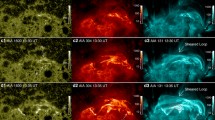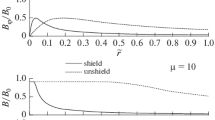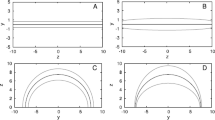Abstract
Magnetic flux ropes (MFRs) are usually considered to be the magnetic structure that dominates the transport of helicity from the Sun into the heliosphere. They entrain a confined plasma within a helically organized magnetic structure and are able to cause geomagnetic activity. The formation, evolution, and twist distribution of MFRs are issues subject to strong debate. Although different twist profiles have been suggested so far, none of them has been thoroughly explored yet. The aim of this work is to present a theoretical study of the conditions under which MFRs with different twist profiles are kink stable and thereby shed some light on the aforementioned aspects. The magnetic field is modeled according to the circular–cylindrical analytical flux rope model in Nieves-Chinchilla et al. (Astrophys. J. 823, 27, 2016) as well as the Lundquist and Gold–Hoyle models, and the kink stability is analyzed with a numerical method that has been developed based on Linton, Longcope, and Fisher (Astrophys. J. 469, 954, 1996). The results are discussed in relation to MFR rotations, magnetic forces, the reversed chirality scenario, and the expansion throughout the heliosphere, among others, providing a theoretical background to improve the current understanding of the internal magnetic configuration of coronal mass ejections (CMEs). The data obtained by new missions like Parker Solar Probe or Solar Orbiter will give the opportunity to explore these results and ideas by observing MFRs closer than ever to the Sun.





Similar content being viewed by others
References
Amari, T., Luciani, J.F., Aly, J.J., Mikic, Z., Linker, J.: 2003, Coronal mass ejection: initiation, magnetic helicity, and flux ropes. I. Boundary motion-driven evolution. Astrophys. J. 585(2), 1073. DOI. ADS.
Antiochos, S.K., DeVore, C.R., Klimchuk, J.A.: 1999, A model for solar coronal mass ejections. Astrophys. J. 510(1), 485. DOI. ADS.
Archontis, V., Török, T.: 2008, Eruption of magnetic flux ropes during flux emergence. Astron. Astrophys. 492(2), L35. DOI. ADS.
Aulanier, G., Janvier, M., Schmieder, B.: 2012, The standard flare model in three dimensions—I. Strong-to-weak shear transition in post-flare loops. Astron. Astrophys. 543, A110. DOI. ADS.
Balmaceda, L.A., Vourlidas, A., Stenborg, G., St. Cyr, O.C.: 2020, On the expansion speed of coronal mass ejections. Implications for self-similar evolution. Solar Phys. 295, 107. DOI. ADS.
Bateman, G.: 1978, MHD Instabilities, MIT Press, Cambridge. ADS.
Bennett, K., Roberts, B., Narain, U.: 1999, Waves in twisted magnetic flux tubes. Solar Phys. 185(1), 41. DOI. ADS.
Berdichevsky, D.B.: 2013, On fields and mass constraints for the uniform propagation of magnetic-flux ropes undergoing isotropic expansion. Solar Phys. 284(1), 245. DOI. ADS.
Berdichevsky, D.B., Lepping, R.P., Farrugia, C.J.: 2003, Geometric considerations of the evolution of magnetic flux ropes. Phys. Rev. E 67, 036405. DOI. ADS.
Bernstein, I.B., Frieman, E.A., Kruskal, M.D., Kulsrud, R.M., Chandrasekhar, S.: 1958, An energy principle for hydromagnetic stability problems. Proc. Roy. Soc. London Ser. A, Math. Phys. Sci. 244(1236), 17. DOI. ADS.
Brent, R.P.: 2013, Algorithms for Minimization Without Derivatives, Courier Corporation, Englewood Cliffs.
Burlaga, L.F.: 1988, Magnetic clouds and force-free fields with constant alpha. J. Geophys. Res. 93(A7), 7217. DOI. ADS.
Burlaga, L., Sittler, E., Mariani, F., Schwenn, R.: 1981, Magnetic loop behind an interplanetary shock: Voyager, Helios, and IMP 8 observations. J. Geophys. Res. 86(A8), 6673. DOI. ADS.
Cabello, I., Cremades, H., Balmaceda, L., Dohmen, I.: 2016, First simultaneous views of the axial and lateral perspectives of a coronal mass ejection. Solar Phys. 291(6), 1799. DOI. ADS.
Chiappinelli, R.: 2019, Nonlinear Rayleigh quotients and nonlinear spectral theory. Symmetry 11(7), 928. DOI.
Cho, K.-S., Park, S.-H., Marubashi, K., Gopalswamy, N., Akiyama, S., Yashiro, S., Kim, R.-S., Lim, E.-K.: 2013, Comparison of helicity signs in interplanetary CMEs and their solar source regions. Solar Phys. 284(1), 105. DOI. ADS.
Cremades, H., Iglesias, F.A., Merenda, L.A.: 2020, Asymmetric expansion of coronal mass ejections in the low corona. Astron. Astrophys. 635, A100. DOI. ADS.
Dasso, S., Mandrini, C.H., Démoulin, P., Luoni, M.L.: 2006, A new model-independent method to compute magnetic helicity in magnetic clouds. Astron. Astrophys. 455(1), 349. DOI. ADS.
Démoulin, P., Dasso, S., Janvier, M., Lanabere, V.: 2019, Re-analysis of Lepping’s fitting method for magnetic clouds: Lundquist fit reloaded. Solar Phys. 294(12), 172. DOI. ADS.
Dungey, J., Loughhead, R.: 1954, Twisted magnetic fields in conducting fluids. Aust. J. Phys. 7(1), 5. DOI. ADS.
Einaudi, G.: 1990, Ideal instabilities in a magnetic flux tube. In: Physics of Magnetic Flux Ropes. Geoph. Monog. Series 58. ADS.
Fan, Y., Gibson, S.E.: 2004, Numerical simulations of three-dimensional coronal magnetic fields resulting from the emergence of twisted magnetic flux tubes. Astrophys. J. 609(2), 1123. DOI. ADS.
Farrugia, C.J., Janoo, L.A., Torbert, R.B., Quinn, J.M., Ogilvie, K.W., Lepping, R.P., Fitzenreiter, R.J., Steinberg, J.T., Lazarus, A.J., Lin, R.P., Larson, D., Dasso, S., Gratton, F.T., Lin, Y., Berdichevsky, D.: 1999, A uniform-twist magnetic flux rope in the solar wind. AIP Conf. Proc. 471(1), 745. DOI. ADS.
Gold, T., Hoyle, F.: 1960, On the origin of solar flares. Mon. Not. Roy. Astron. Soc. 120(2), 89. DOI. ADS.
Goldstein, H.: 1983, On the field configuration in magnetic clouds. NASA Conf. Publ. 228, 731. ADS.
Gosling, J.T.: 1990, Coronal mass ejections and magnetic flux ropes in interplanetary space. In: Physics of Magnetic Flux Ropes. Geoph. Monog. Series 58. DOI. ADS.
Hau, L.N., Sonnerup, B.U.O.: 1999, Two-dimensional coherent structures in the magnetopause: recovery of static equilibria from single-spacecraft data. J. Geophys. Res. 104(A4), 6899. DOI. ADS.
Hidalgo, M.A., Nieves-Chinchilla, T., Cid, C.: 2002, Elliptical cross-section model for the magnetic topology of magnetic clouds. Geophys. Res. Lett. 29(13), 1637. DOI. ADS.
Hidalgo, M.A., Cid, C., Vinas, A.F., Sequeiros, J.: 2002, A non-force-free approach to the topology of magnetic clouds in the solar wind. J. Geophys. Res. 107(A1), 1002. DOI. ADS.
Hood, A.W., Priest, E.R.: 1979, Kink instability of solar coronal loops as the cause of solar flares. Solar Phys. 64(2), 303. DOI. ADS.
Hood, A.W., Priest, E.R.: 1981, Critical conditions for magnetic instabilities in force-free coronal loops. Geophys. Astrophys. Fluid Dyn. 17(1), 297. DOI. ADS.
Hu, Q.: 2017, The Grad–Shafranov reconstruction in twenty years: 1996–2016. Adv. Sci. China. Earth Sci. 60, 1466. DOI. ADS.
Hu, Q., Qiu, J., Krucker, S.: 2015, Magnetic field line lengths inside interplanetary magnetic flux ropes. J. Geophys. Res. 120(7), 5266. DOI. ADS.
Hu, Q., Qiu, J., Dasgupta, B., Khare, A., Webb, G.M.: 2014, Structures of interplanetary magnetic flux ropes and comparison with their solar sources. Astrophys. J. 793(1), 53. DOI. ADS.
Kahler, S.W., Krucker, S., Szabo, A.: 2011, Solar energetic electron probes of magnetic cloud field line lengths. J. Geophys. Res. 116(A1), A01104. DOI. ADS.
Kay, C., Opher, M., Evans, R.M.: 2015, Global trends of CME deflections based on CME and solar parameters. Astrophys. J. 805(2), 168. DOI. ADS.
Kazachenko, M.D., Canfield, R.C., Longcope, D.W., Qiu, J.: 2010, Sunspot rotation, flare energetics, and flux rope helicity: the Halloween Flare on 2003 October 28. Astrophys. J. 722(2), 1539. DOI. ADS.
Knizhnik, K.J., Linton, M.G., DeVore, C.R.: 2018, The role of twist in kinked flux rope emergence and delta-spot formation. Astrophys. J. 864(1), 89. DOI. ADS.
Kopp, R.A., Pneuman, G.W.: 1976, Magnetic reconnection in the corona and the loop prominence phenomenon. Solar Phys. 50(1), 85. DOI. ADS.
Kruskal, M.D., Johnson, J.L., Gottlieb, M.B., Goldman, L.M.: 1958, Hydromagnetic instability in a stellarator. Phys. Fluids 1, 421. DOI. ADS.
Kutchko, F.J., Briggs, P.R., Armstrong, T.P.: 1982, The bidirectional particle event of October 12, 1977, possibly associated with a magnetic loop. J. Geophys. Res. 87(A3), 1419. DOI. ADS.
Lanabere, V., Dasso, S., Démoulin, P., Janvier, M., Rodriguez, L., Masías-Meza, J.J.: 2020, Magnetic twist profile inside magnetic clouds derived with a superposed epoch analysis. Astron. Astrophys. 635, A85. DOI. ADS.
Larson, D.E., Lin, R.P., McTiernan, J.M., McFadden, J.P., Ergun, R.E., McCarthy, M., Rème, H., Sanderson, T.R., Kaiser, M., Lepping, R.P., Mazur, J.: 1997, Tracing the topology of the October 18–20, 1995, magnetic cloud with \(\sim 0.1\)–\(10^{2}\) keV electrons. Geophys. Res. Lett. 24(15), 1911. DOI. ADS.
Lepping, R.P., Jones, J.A., Burlaga, L.F.: 1990, Magnetic field structure of interplanetary magnetic clouds at 1 AU. J. Geophys. Res. 95(A8), 11957. DOI. ADS.
Lepping, R.P., Wu, C.-C.: 2010, Selection effects in identifying magnetic clouds and the importance of the closest approach parameter. Ann. Geophys. 28(8), 1539. DOI. ADS.
Lepping, R.P., Berdichevsky, D.B., Wu, C.-C., Szabo, A., Narock, T., Mariani, F., Lazarus, A.J., Quivers, A.J.: 2006, A summary of WIND magnetic clouds for years 1995–2003: model-fitted parameters, associated errors and classifications. Ann. Geophys. 24(1), 215. DOI. ADS.
Lepping, R.P., Wu, C.-C., Berdichevsky, D.B., Szabo, A.: 2018, Wind magnetic clouds for the period 2013–2015: model fitting, types, associated shock waves, and comparisons to other periods. Solar Phys. 293(4), 65. DOI. ADS.
Lifschitz, A.E.: 1989, Magnetohydrodynamics and Spectral Theory, Developments in Electromagnetic Theory and Applications 4, Kluwer Academic Publishers, Boston. DOI.
Linton, M.G., Longcope, D.W., Fisher, G.H.: 1996, The helical kink instability of isolated, twisted magnetic flux tubes. Astrophys. J. 469, 954. DOI. ADS.
Linton, M.G., Dahlburg, R.B., Fisher, G.H., Longcope, D.W.: 1998, Nonlinear evolution of kink-unstable magnetic flux tubes and solar \(\delta \)-spot active regions. Astrophys. J. 507(1), 404. DOI. ADS.
Linton, M.G., Fisher, G.H., Dahlburg, R.B., Fan, Y.: 1999, Relationship of the multimode kink instability to \(\delta \)-spot formation. Astrophys. J. 522(2), 1190. DOI. ADS.
Longcope, D.W., Beveridge, C.: 2007, A quantitative, topological model of reconnection and flux rope formation in a two-ribbon flare. Astrophys. J. 669(1), 621. DOI. ADS.
Longcope, D.W., Fisher, G.H., Arendt, S.: 1996, The evolution and fragmentation of rising magnetic flux tubes. Astrophys. J. 464, 999. DOI. ADS.
Lundquist, S.: 1951, On the stability of magneto-hydrostatic fields. Phys. Rev. 83(2), 307. DOI. ADS.
Lynch, B.J., Antiochos, S.K., MacNeice, P.J., Zurbuchen, T.H., Fisk, L.A.: 2004, Observable properties of the breakout model for coronal mass ejections. Astrophys. J. 617(1), 589. DOI. ADS.
Mikic, Z., Schnack, D.D., van Hoven, G.: 1990, Dynamical evolution of twisted magnetic flux tubes. I. Equilibrium and linear stability. Astrophys. J. 361, 690. DOI. ADS.
Moore, R.L., Labonte, B.J.: 1980, The filament eruption in the 3B flare of July 29, 1973—onset and magnetic field configuration. In: Solar and Interplanetary Dynamics, IAU Symp. 91, 207. ADS.
Moore, R.L., Sterling, A.C., Hudson, H.S., Lemen, J.R.: 2001, Onset of the magnetic explosion in solar flares and coronal mass ejections. Astrophys. J. 552(2), 833. DOI. ADS.
Mulligan, T., Russell, C.T.: 2001, Multispacecraft modeling of the flux rope structure of interplanetary coronal mass ejections: cylindrically symmetric versus nonsymmetric topologies. J. Geophys. Res. 106(A6), 10581. DOI. ADS.
Myers, C.E., Yamada, M., Ji, H., Yoo, J., Fox, W., Jara-Almonte, J., Savcheva, A., Deluca, E.E.: 2015, A dynamic magnetic tension force as the cause of failed solar eruptions. Nature 528(7583), 526. DOI. ADS.
Nieves-Chinchilla, T.: 2018, Modeling heliospheric flux ropes: A comparative study of physical quantities. IEEE Trans. Plasma Sci. 46(7), 2370. DOI. ADS.
Nieves-Chinchilla, T., Colaninno, R., Vourlidas, A., Szabo, A., Lepping, R.P., Boardsen, S.A., Anderson, B.J., Korth, H.: 2012, Remote and in situ observations of an unusual Earth-directed coronal mass ejection from multiple viewpoints. J. Geophys. Res. 117(A6), A06106. DOI. ADS.
Nieves-Chinchilla, T., Linton, M.G., Hidalgo, M.A., Vourlidas, A., Savani, N.P., Szabo, A., Farrugia, C., Yu, W.: 2016, A circular-cylindrical flux-rope analytical model for magnetic clouds. Astrophys. J. 823(1), 27. DOI. ADS.
Nieves-Chinchilla, T., Linton, M.G., Hidalgo, M.A., Vourlidas, A.: 2018, Elliptic-cylindrical analytical flux rope model for magnetic clouds. Astrophys. J. 861(2), 139. DOI. ADS.
Nieves-Chinchilla, T., Jian, L.K., Balmaceda, L., Vourlidas, A., dos Santos, L.F.G., Szabo, A.: 2019, Unraveling the internal magnetic field structure of the Earth-directed interplanetary coronal mass ejections during 1995–2015. Solar Phys. 294(7), 89. DOI. ADS.
Oliphant, T.: 2019, SciPy ‘odeint’ function. https://github.com/scipy/scipy/blob/v1.4.1/scipy/integrate/odepack.py#L29-L260.
Oz, E., Myers, C.E., Yamada, M., Ji, H., Kulsrud, R.M., Xie, J.: 2011, Experimental verification of the Kruskal-Shafranov stability limit in line-tied partial-toroidal plasmas. Phys. Plasmas 18, 102107. DOI. ADS.
Priest, E.R.: 1990, The equilibrium of magnetic flux ropes (tutorial lecture). In: Physics of Magnetic Flux Ropes. Geoph. Monog. Series 58. DOI. ADS.
Richardson, I.G., Cane, H.V.: 2004, The fraction of interplanetary coronal mass ejections that are magnetic clouds: evidence for a solar cycle variation. Geophys. Res. Lett. 31(18), L18804. DOI. ADS.
Rinne, H.: 2009, The Weibull Distribution: A Handbook, CRC Press, Boca Raton.
Romashets, E.P., Vandas, M.: 2003, Force-free field inside a toroidal magnetic cloud. Geophys. Res. Lett. 30(20), 2065. DOI. ADS.
Schuessler, M.: 1979, Magnetic buoyancy revisited: analytical and numerical results for rising flux tubes. Astron. Astrophys. 71(1–2), 79. ADS.
Schwarzschild, B.M.: 1981, Reversed-field pinch stable 8 msec. Phys. Today 34(9), 20. DOI. ADS.
Shafranov, V.D.: 1958, On magnetohydrodynamical equilibrium configurations. J. Exp. Theor. Phys. 6, 545. ADS.
Sterling, A.C., Moore, R.L.: 2004, Evidence for gradual external reconnection before explosive eruption of a solar filament. Astrophys. J. 602(2), 1024. DOI. ADS.
Subramanian, P., Arunbabu, K.P., Vourlidas, A., Mauriya, A.: 2014, Self-similar expansion of solar coronal mass ejections: implications for Lorentz self-force driving. Astrophys. J. 790(2), 125. DOI. ADS.
Titov, V.S., Démoulin, P.: 1999, Basic topology of twisted magnetic configurations in solar flares. Astron. Astrophys. 351, 707. ADS.
Török, T., Kliem, B.: 2005, Confined and ejective eruptions of kink-unstable flux ropes. Astrophys. J. Lett. 630(1), L97. DOI. ADS.
Török, T., Kliem, B.: 2007, Numerical simulations of fast and slow coronal mass ejections. Astron. Nachr. 328(8), 743. DOI. ADS.
van Ballegooijen, A.A., Martens, P.C.H.: 1989, Formation and eruption of solar prominences. Astrophys. J. 343, 971. DOI. ADS.
Vemareddy, P., Cheng, X., Ravindra, B.: 2016, Sunspot rotation as a driver of major solar eruptions in the NOAA active region 12158. Astrophys. J. 829(1), 24. DOI. ADS.
Vemareddy, P., Démoulin, P.: 2017, Successive injection of opposite magnetic helicity in Solar active region NOAA 11928. Astron. Astrophys. 597, A104. DOI. ADS.
Voslamber, D., Callebaut, D.K.: 1962, Stability of force-free magnetic fields. Phys. Rev. 128, 2016. DOI. ADS.
Vourlidas, A., Colaninno, R., Nieves-Chinchilla, T., Stenborg, G.: 2011, The first observation of a rapidly rotating coronal mass ejection in the middle corona. Astrophys. J. Lett. 733(2), L23. DOI. ADS.
Wang, Y., Zhuang, B., Hu, Q., Liu, R., Shen, C., Chi, Y.: 2016, On the twists of interplanetary magnetic flux ropes observed at 1 AU. J. Geophys. Res. 121(10), 9316. DOI. ADS.
Wang, Y., Shen, C., Liu, R., Liu, J., Guo, J., Li, X., Xu, M., Hu, Q., Zhang, T.: 2018, Understanding the twist distribution inside magnetic flux ropes by anatomizing an interplanetary magnetic cloud: twist distribution in an interplanetary MC. J. Geophys. Res. 123(5), 3238. DOI. ADS.
Woltjer, L.: 1958, A theorem on force-free magnetic fields. Proc. Natl. Acad. Sci. USA 44, 489. DOI. ADS.
Yurchyshyn, V., Abramenko, V., Tripathi, D.: 2009, Rotation of white-light coronal mass ejection structures as inferred from LASCO coronagraph. Astrophys. J. 705(1), 426. DOI. ADS.
Acknowledgements
M. Florido-Llinas thanks CFIS (UPC) and her family for the funding support, and is very grateful to the Heliospheric Physics Laboratory (HSD) at NASA Goddard Space Flight Center for providing the hosting and guidance to carry out this research as part of her bachelor thesis. The work of T. Nieves-Chinchilla is supported by the Solar Orbiter and Parker Solar Probe missions. The work of M.G. Linton is supported by the Office of Naval Research 6.1 program and by the NASA Living With a Star program.
Author information
Authors and Affiliations
Corresponding author
Ethics declarations
Disclosure of Potential Conflicts of Interest
The authors declare that they have no conflicts of interest.
Additional information
Publisher’s Note
Springer Nature remains neutral with regard to jurisdictional claims in published maps and institutional affiliations.
This article belongs to the Topical Collection:
Towards Future Research on Space Weather Drivers
Guest Editors: Hebe Cremades and Teresa Nieves-Chinchilla
Rights and permissions
About this article
Cite this article
Florido-Llinas, M., Nieves-Chinchilla, T. & Linton, M.G. Analysis of the Helical Kink Stability of Differently Twisted Magnetic Flux Ropes. Sol Phys 295, 118 (2020). https://doi.org/10.1007/s11207-020-01687-z
Received:
Accepted:
Published:
DOI: https://doi.org/10.1007/s11207-020-01687-z




